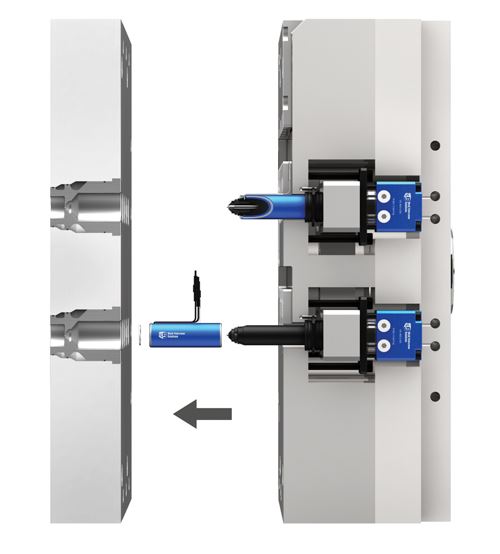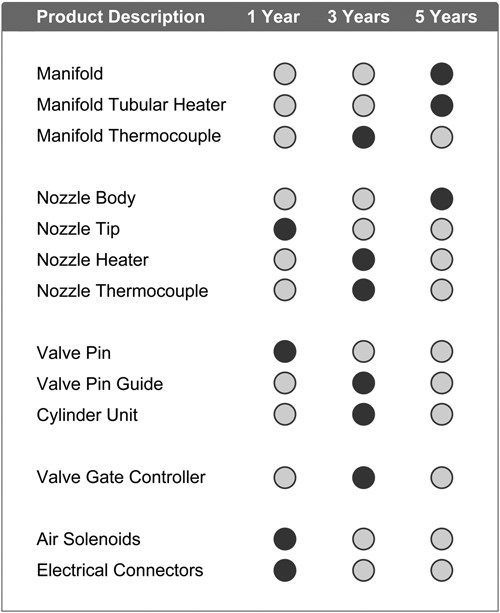Going Long in Zinc
It can be tough, in the midst of as bad a recession as many of us have experienced, to consider investing in new equipment and processes.
It can be tough, in the midst of as bad a recession as many of us have experienced, to consider investing in new equipment and processes. It can be even harder to justify purchasing brand-new plating hardware when the market is overflowing with used process lines and ancillary equipment.
Yet C.R. Hudgins Plating (Lynchburg, VA) did just that, and the company's decision is already paying off in terms of new business and a growing national reputation.
Launched as a plating shop in 1948, the family-run business has a history of committing to significant capital expenditures to expand and upgrade its process offerings, reduce energy consumption and make sure its environmental controls are more than what is required. For example, after decades of focusing on plating services, in 1990 Hudgins diversified to organic finishing with the addition of powder coating capability.
The company currently operates five automated zinc rack and barrel lines, the powder line, and chromating and passivating lines from a 100,000 ft2 facility with 60 full-time employees. Post-finishing operations including light assembly and hardware insertion add value for customers in the electrical supply, heavy equipment and other industries. Hudgins recently achieved ISO 9001:2000 certification.
Timing is Everything
Executive vice president Bobby Robbins outlines the history of the company's latest project and explains the management team's rationale for committing to such a significant capital investment in the midst of recession. "A couple of years ago, we received a call from a company that was moving from the Midwest to Virginia," he recalls. "They were looking for a shop that could plate a length of 20 ft.
"At that time, the longest length we could do was about 12 ft, so they went elsewhere. But a year or so later they called back. After discussions about the volume they expected, we decided to start looking into a new line to handle the work."
Based on the production volume indicated by the first customer, Hudgins' executive team (Robbins and co-CEOs Byron and Renee Hudgins) pondered whether or not to take the plunge. "Even though we had a customer asking for the capability, it was still a risk," Robbins says. "They only offered the volume of work; they weren't offering any capital or anything like that to start up."
But managers didn't sit still. Instead, they began to search for other potential customers who might want zinc electroplating of 20-ft lengths. "It turned out there was a surprising amount of interest," Robbins says. "Instead of a single customer, we wound up with four or five who basically said, 'If you put it in, give us a call.'"
Robbins began talking with potential suppliers, eventually settling on Jessup Engineering, Inc. (Rochester Hills, MI) to engineer the line and Columbia Chemical Corp. (Brunswick, OH) and its distributor ) PNP Specialty Chemical (Greensboro, NC) as the chemistry supplier.
According to Robbins, the fact that the U.S. was in the midst of a severe recession actually worked in Hudgins' favor once the project got going. "When we started negotiating with the equipment manufacturers, the state of the economy helped us," he recalls. "Their shops were slow, and the economy being in such bad shape enabled us to get some really good pricing on equipment. We also got a lot of help from our chemical suppliers. Everyone kind of jumped on board with us and helped make this thing come alive."
Line Details
Currently being used to plate struts and tubing for electrical and heavy equipment applications, the line has throughput of five flight bars/hr. Hudgins is currently processing a variety of tube ODs and wall thicknesses.
Tanks are 21.5 ft long to accommodate the 20-ft workpieces, and the current zinc plating bath setup consists of two cells with a total capacity near 4500 gal. The line was engineered to accommodate an additional two plating cells and another 4000-lb hoist.
Plating is followed by a bright dip and one of two chromates—a trivalent blue and hexavalent yellow—plus a final hot water rinse and seal. A single 4,000-lb hoist features a tilt capability that facilitates drainage of the long workpieces. "When we started running samples we ran into a lot of drainage problems," Robbins recalls. "Jessup engineered a hoist that tilts five degrees when it's at full lift. The tilting reduces drainage time and minimizes drag-out. That's one of the big keys that helps us plate those long parts."
The line also contains other unique features that reduce water consumption and facilitate quality production. Water, for example, is supplied to the line only when the hoist lifts. "On our other equipment, we're still steadily pumping water to the line even if it's idle," Robbins says. "This line is programmed to give a burst of 5 gal of water every time the hoist lifts. So the line doesn't get any more water until another flight bar goes in and the first bar is lifted."
Additions of some chemicals to the plating tank are similarly automated. Brightener and zinc metal are added based on amp-hours of operation. "Every 1,000 or so amp-hours, the system turns on the brightener pump for a preset time," Robbins explains. "The zinc generator system works the same way."
Those capabilities, plus overall process monitoring and control, are made possible by Jessup's PLC-based control system. It uses touch-screen PCs for operator interface and programming, eliminating the need for more specialized PLC programming. The system has on-board storage of up to 10,000 process recipes, which are uploaded via bar code, plus on-board storage and export of process quality data.
All chemistries used, from the initial alkaline cleaning stage to final sealing, are supplied by Columbia Chemical. In the plating tank is the company's ColZinc ACF-II process, which is said to offer good brightness over a wide current density range, excellent throwing power, and superior ductility.
At least as important from the perspective of C.R. Hudgins was the ability of deposits to meet customer corrosion specifications. "We did a lot of testing to meet the initial customer's salt-spray requirement," Robbins explains. "The tubes are straight when we plate them, then they are bent. The customer wanted salt-spray performance of 400 hr to red rust after bending—a pretty tall order. We tested a lot of different products, and the Columbia chemistry turned out to be the best."
The Process
According to Robbins, processing on the 20-ft line is different than on Hudgins' other zinc rack lines, which handle shorter part lengths. For one thing, the company spends a lot more time on cleaning.
"The first step is an alkaline soak cleaner," he says. "That's followed by two rinses, an acid pickle, and two more rinses before parts go for a second pass through the soak cleaner. The double cleaning eliminates manual line operation if we have rework material and helps remove oil from the tube ID."
The second soak cleaning is followed by electrocleaning, two rinses and the plating tank. Parts spend about 20 min in the zinc tank to achieve a minimum deposit thickness of 0.0002–0.0003 inches.
Plated parts then receive a bright dip of 1% nitric acid. "This step neutralizes any alkalinity left from the plating bath," Robbins explains. "Alkalinity can pretty much kill the new trivalent chromate chemistries, which are already more expensive to operate than hexavalent formulations."
According to Robbins, the final seal and hot-water rinse are important process steps to prevent premature corrosion of finished parts. "The seal formulation has an additive that coats the inside of the tube to prevent it from corroding before it gets assembled. If we didn't have that, we'd probably have flash rusting on the tube ID," he says.
As previously mentioned, plating tank chemistry control is automated based on amp-hours of operations. In cleaning and other sections, Hudgins operators titrate daily to control tank chemistries and make additions as needed.
Wastewater treatment is handled by a system Hudgins had installed at the end of 2008. Fully automated with a touch-screen operator interface, it features a closed-loop evaporator that eliminated natural gas usage for drying and evaporation.
According to Robbins, addition of the 20-ft line is paying off in ways both foreseen and unexpected. "It's helped us expand our business geographically," he says. "Before, we were pretty much limited to a radius of maybe 250 miles. Now we're getting interest and work from companies more than 700 miles away.
"And, not only are we getting 20-ft pieces, we're getting shorter jobs that we can run on our other lines. If we hadn't installed the new equipment that could handle 20-ft lengths, we wouldn't have gotten the shorter jobs. So it actually gave a boost to our existing lines as well. It's even helped out our powder coating business."
Read Next
Getting Better All the Time
Trivalent black passivates currently in use reflect the great strides made in appearance, corrosion protection, and solution life. All these are improved and the processes are a little more like the old two-part hex black. However, they still employ multiple additives and controllers to maintain the solution.
Read MoreDelivering Increased Benefits to Greenhouse Films
Baystar's Borstar technology is helping customers deliver better, more reliable production methods to greenhouse agriculture.
Read MoreA ‘Clean’ Agenda Offers Unique Presentations in Chicago
The 2024 Parts Cleaning Conference, co-located with the International Manufacturing Technology Show, includes presentations by several speakers who are new to the conference and topics that have not been covered in past editions of this event.
Read More











.jpg;maxWidth=300;quality=90)












